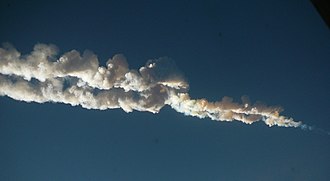PAST KNOWN STRIKES
Based on crater formation rates determined from the Earth's closest celestial
partner, the Moon, astrogeologists have determined that during the last 600
million years, the Earth has been struck by 60 objects of a diameter of 5 km
(3 mi) or more.[citation needed] The smallest of these impacts would leave a
crater almost 100 km (60 mi) across. Only three confirmed craters from that
time period with that size or greater have been found: Chicxulub, Popigai,
and Manicouagan, and all three have been suspected of being linked to
extinction events[29][30] though only Chicxulub, the largest of the three,
has been consistently considered. The impact that caused Mistastin crater
generated temperatures exceeding 2,370 °C, the highest known to have occurred
on the surface of the Earth.
Besides direct effect of asteroid impacts on a planet's surface topography,
global climate and life, recent studies have shown that several consecutive
impacts might have an effect on the dynamo mechanism at a planet's core
responsible for maintaining the magnetic field of the planet, and might
eventually shut down the planet's magnetic field
An impact event is commonly seen as a scenario that would bring about the
end of civilization. In 2000, Discover Magazine published a list of 20
possible sudden doomsday scenarios with an impact event listed as the most
likely to occur
More Earth Impacts:
1. The leading theory of the Moon's origin is the giant impact theory, which
postulates that Earth was once hit by a planetoid the size of Mars; such a
theory is able to explain the size and composition of the Moon, something not
done by other theories of lunar formation.
2. Evidence of a massive impact in South Africa near a geological
formation known as the Barberton Greenstone Belt was uncovered by scientists
in April 2014. They estimated the impact occurred about 3.26 billion years ago
and that the impactor was approximately 37–58 kilometers (23–36 miles) wide.
The crater from this event, if it still exists, has not yet been found.
3. Two 10-kilometre sized asteroids are now believed to have struck
Australia between 360 and 300 million years ago at the Western Warburton and
East Warburton Basins creating a 400-kilometer impact zone. According to
evidence found in 2015 it is the largest ever recorded.[50] A third, possible
impact was also identified in 2015 to the north, on the upper Diamantina River,
also believed to have been caused by an asteroid 10 km across about 300 million
years ago, but further studies are needed to establish that this crustal
anomaly was indeed the result of an impact event.
20th Century Imapcts:
One of the best-known recorded impacts in modern times was the Tunguska event,
which occurred in Siberia, Russia, in 1908. This incident involved an explosion
that was probably caused by the airburst of an asteroid or comet 5 to 10 km
(3.1 to 6.2 mi) above the Earth's surface, felling an estimated 80 million
trees over 2,150 km2 (830 sq mi)
In February 1947, another large bolide impacted the Earth in the Sikhote-Alin
Mountains, Primorye, Soviet Union. It was during daytime hours and was
witnessed by many people, which allowed V. G. Fesenkov, then chairman of the
meteorite committee of the USSR Academy of Science, to estimate the meteoroid's
orbit before it encountered the Earth. Sikhote-Alin is a massive fall with the
overall size of the meteoroid estimated at approximately 90,000 kg (200,000 lb).
A more recent estimate by Tsvetkov (and others) puts the mass at around 100,000
kg (220,000 lb).[62] It was an iron meteorite belonging to the chemical group
IIAB and with a coarse octahedrite structure. More than 70 tonnes (metric tons)
of material survived the collision.
21st Century Hits:
- On 7 June 2006, a meteor was observed striking Reisadalen in Nordreisa
municipality in Troms County, Norway.
- On 15 September 2007, a chondritic meteor crashed near the village of
Carancas in southeastern Peru near Lake Titicaca
- On 7 October 2008, an approximately 4 meter asteroid labeled 2008 TC3 was
tracked for 20 hours as it approached Earth and as it fell through the
atmosphere and impacted in Sudan.
- On 15 February 2013, an asteroid entered Earth's atmosphere over Russia as
a fireball and exploded above the city of Chelyabinsk
- On 1 January 2014, a 3-meter (10 foot) asteroid, 2014 AA was discovered by
the Mount Lemmon Survey and observed over the next hour, and was soon
found to be on a collision course with Earth.
- On 2 June 2018, the Mount Lemmon Survey detected 2018 LA (ZLAF9B2), a
small 2-5 meter asteroid which further observations soon found had an 85%
chance of impacting Earth. Soon after the impact, a fireball report from
Botswana arrived to the American Meteor Society
- On 8 March 2019, NASA announced the detection of a large airburst that
occurred on 18 December 2018 at 11:48 local time off the eastern coast of
the Kamchatka Peninsula. The Kamchatka superbolide is estimated to have
had a mass of roughly 1600 tons, and a diameter of 9 to 14 meters
depending on its density, making it the third largest asteroid to impact
Earth since 1900, after the Chelyabinsk meteor and the Tunguska event. The
fireball exploded in an airburst 25.6 kilometers (15.9 mi) above Earth's
surface.
- 2019 MO, an approximately 4m asteroid, was detected by ATLAS a few hours
before it impacted near Puerto Rico in June 2019

